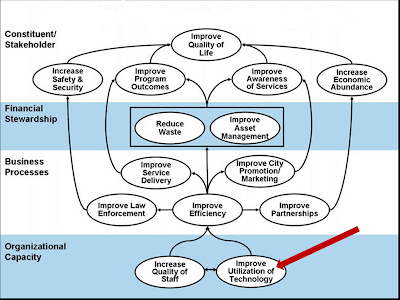- Sets priorities and makes budget decisions
- Helps anticipate changes in the environment and adjust accordingly
- Establishes shared goals & strategies to help align everyone’s activities with the direction of the organization
Establishing a clear understanding of the organization and the environment in which it operates is an important starting point for strategic planning. The organizational assessment, introduced in the previous entry, is the approach typically applied to achieve this understanding. During the assessment, interviews with key stakeholders are conducted to gather information to be included in a profile describing the organizational environment. Many interview responses will also help to formulate key parts of the strategic plan.
There are many potential interview questions that can be asked as part of the assessment. Each assessment interview tool should be tailored to the organization being assessed. However, I have found this set of questions useful in many different strategic planning projects for technology services:
- Who are you?
- Name?
- Job Title?
- Department-Division?
- Direct Manager?
- Direct Reports?
- What current systems are used in your Department-Division?
- System = a technology-enabled mechanism that supports business operations or service delivery through voice, text, image, application, software, hardware, network, or other data processing, storage, communication, or sharing. Some examples could be a document management system, an accounting system, a work order system, an on-line payment system, a desktop data management application, a voice radio system, or wireless phone system with Push-to-Talk functionality for job-site communications.
- For each current system, what business processes are supported?
- A business process is a set of coordinated activities that accomplish a specific organizational goal—like producing a service or product that delivers value to a specific type of customer. People, systems, or other resources interact with the business process and execute process activities. Examples of business processes could include payment requisition processing in Accounting, or customer order processing in Sales.
- For each current system, who are the users?
- Which people use which current systems? What are their job/participant roles/functions? How many people are in each role?
- For each current system, what are the existing integrations or interfaces?
- What are the interactions between current systems and other systems, departments, partners, or other entities? What data is provided to or requested from inside or outside entities?
- For each current system, what are its issues or constraints?
- Are there opportunities to improve, or limitations to the effectiveness of, current systems?
- What modified or new systems capabilities do you need to successfully conduct operations and deliver services in the next one or two years?
- What modified or new systems capabilities do you need to successfully conduct operations and deliver services in the following three to five years?
- What modified or new systems capabilities do you envision successfully conducting operations and delivering services in the following six to ten years?
- Is there anything else concerning technology services, support, or related activities that you would like to share?



